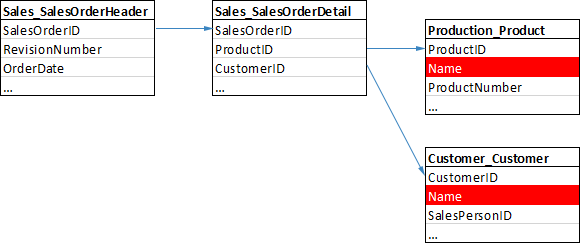The Merge method of MailMerge accepts a DataTable as a parameter. This table acts as the master table for the merge process.
MergeField names without a prefix in the template are matched to this table and doesn't require a prefix. The rows of the master table are used to create the document instances of the template. In other words: The number of resulting documents in a merge process depends on the number of records in the master table.
All relations between child tables and the master table is defined as a prefix in the merge field name concatenated with a dot:
ChildTable[.ChildTable].ColumnName
Our sample database has the following structure:

In case the master table is Sales_SalesOrderHeader, the merge field values for MergeFields without a prefix are coming from this table. If MergeFields have a prefix, the values are coming from related tables such as Sales_SalesOrderDetail:
Sales_SalesOrdcerDetail.ProductID
The number of records in a merge process is based on the number of records in the master table. That implies that the complete template will be populated with all records available in the master table. This is easier to understand, if the table structure is illustrated as an XML file:
<Report>
<Sales_SalesOrderHeader>
<SalesOrderID>1</SalesOrderID>
<OrderDate>12-12-2014</OrderDate>
<RevisionDate>12-12-2014</RevisionDate>
</Sales_SalesOrderHeader>
<Sales_SalesOrderHeader>
<SalesOrderID>2</SalesOrderID>
<OrderDate>11-12-2014</OrderDate>
<RevisionDate>11-12-2014</RevisionDate>
</Sales_SalesOrderHeader>
<Sales_SalesOrderDetail>
<SalesOrderID>1</SalesOrderID>
<ProductID>3</ProductID>
<CustomerID>12</CustomerID>
</Sales_SalesOrderDetail>
<Sales_SalesOrderDetail>
<SalesOrderID>2</SalesOrderID>
<ProductID>4</ProductID>
<CustomerID>13</CustomerID>
</Sales_SalesOrderDetail>
</Report>If Sales_SalesOrderHeader is the master table, the template will be processed 2 times as there are 2 records available in the data source.
The master table is the base table for the complete report. Inside of merge blocks, the master table for this block is the merge block table. All child tables of this block table can be used inside of the merge block with the same notation. In other words: Each merge block as a new master table and relations are based on the block master table.

